Even slight stretching muscles of the back of the thigh is a limb injury that requires special attention and treatment. You can get this type of damage due to improper preparation for sports training or even with a morning pace, while cleaning the house. It is enough to unsuccessfully put a leg and then experience severe pain and discomfort for a long time.
Record content:
- 1 Muscular anatomy of the back of the thigh
- 2 Stretching reasons
- 3 Sprains and severity
- 4 Helping the victim at home
- 5 When and which doctor should I go to?
- 6 Diagnostics
- 7 Conservative treatment
-
8 Restorative activities
- 8.1 Physiotherapy
- 8.2 Exercise therapy
- 8.3 Massage
- 8.4 Taping and elastic bandage
- 9 Terms of rehabilitation
- 10 Folk methods
- 11 Possible complications of spraining
- 12 Forecast
- 13 Thigh Stretch Videos
Muscular anatomy of the back of the thigh
The thigh muscles of the human body can be divided into 3 categories:
- Back group. These muscles are also called flexors. When the biceps flexor contracts, the knee rotates. The rest of the muscles in this group are responsible for the mobility of the lower limb when it rotates inward. The semi-transverse and popliteal muscles affect exclusively the knee joint.
- Front group. It includes a tailor's, intermediate broad, quadriceps muscle. This group also includes the rectus, medial vastus, and lateral vastus.
- Medial group. These muscles are called adductors. This category includes scallop, slender, short, long and large conductive muscles. They are all located on the inner thigh. Due to these muscles, the thigh is rotated, as well as its turn outward. In addition, the muscles of this group allow flexion of the hip composition.
The posterior part of the thigh includes the gluteus maximus, semi-transverse, biceps, tendon, adductor and gastrocnemius muscles. If they are damaged, a person may experience sharp and severe pain.
Pain syndrome is formed immediately after injury. After that, the person notes limited mobility and increased pain when moving. Also, when stretching, swelling appears, signs of hematoma are often noted.
Stretching reasons
A sprain on the back of the thigh, which is best treated immediately, can occur due to various factors. With smooth and insignificant loads on the hip joint, the load is minimal, since it is distributed over many muscles of the limb.
However, with a sharp turn and movement, the loads do not have time to be distributed, which most often leads to the fact that the muscles cannot cope with such a task, stretching occurs.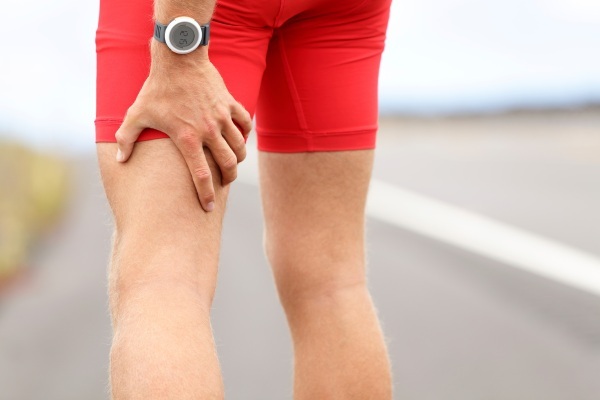
The main causes of this type of injury include:
- a sharp change in body position (especially if a person has been sitting in one position for a long time);
- increased loads during training without proper preparation (even experienced athletes always warm up their muscles before exercise);
- loss of muscle elasticity (can develop with age or if a person has been without movement for a long time);
- increased power loads (for example, if at work a person has to lift weights throughout the day);
- external impact (fall, impact, collision and other types of mechanical injury).
Sprains and severity
There are several types of sprains, depending on the specific site of injury and the tissue that was affected.
Based on this, there are the following defeats:
-
Back area. These are injuries that affect the semitendinosus structure, located in the biceps or semi-transverse muscle.

- Medial part. Most often, the structure of the conductive type suffers.
- Front area. It is more difficult to damage the structures of this zone. However, the rectus muscle located in this area has a special type of attachment. It is attached to the knee joint and runs to the hip region. Therefore, damage to this separate area of the anterior region of the thigh occurs more often.
- Muscles located in the hip area. They are also responsible for the accuracy of movement. As a rule, sprains in the hip region are equally common in professional athletes and people who do not play sports. Muscles can be damaged by impact, unsuccessful fall, and strong physical exertion.
- Ligaments and tendons. These are injuries of a complicated type, since in this case the pain syndrome is much stronger, and treatment and rehabilitation takes longer. As a rule, damage to the ligaments and tendons is associated with prolonged physical impact on the leg, due to which the structures lose their elasticity. For example, loaders face similar injuries, people who perform exercises with their legs wide apart, those who have suffered from blows to the lower limbs.
There are 3 degrees of muscle stretching:
| Degree | Description |
| I-i | Light sprain, in which there is slight discomfort in the limb. There is mobility, but mild pain is observed in the back of the leg. The pain syndrome persists for several days, after which it disappears. A person can move in the usual way after 5-10 days. |
| II | Quite severe cramping. A person cannot play sports, mobility is impaired. Pain syndrome does not allow full movement for several days. After a few days, a hematoma appears on the leg. At the same time, the patient cannot fully stretch the leg due to severe pain. |
| III | Acute pain. The spasms are so severe that it can even cause a person to fall. It becomes impossible to move, the limbs are unable to bend and unbend. Treatment is required, as otherwise blood begins to accumulate under the skin. Pain syndrome and spasms persist for several weeks, during which a person is unable to move independently. |
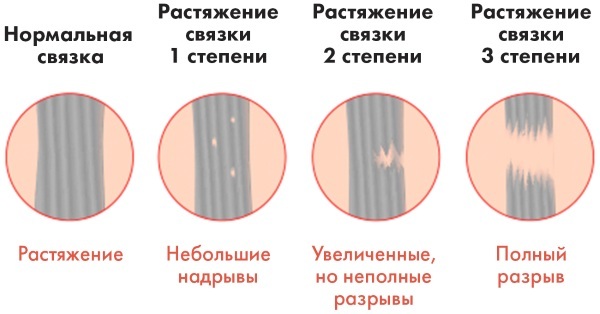
Stretching the posterior surface of the thigh, the treatment of which may be necessary or not necessary (with the 1st degree of damage), requires close attention. If alarming symptoms and limited movement persist for more than 2-3 days, then you must definitely go to the hospital.
Helping the victim at home
It is very difficult to determine exactly how serious an injury is at home. Comprehensive diagnostic measures are required. Otherwise, it is very easy to confuse an ordinary injury with a micro-injury of the ligament. If the condition of a person is incorrectly assessed, then there is a risk that the damaged structures will grow together incorrectly in the future.
First aid for sprains is:
- Restriction of the victim's mobility. The person must be laid in a horizontal position. It is recommended to put a pillow or an impromptu clothes roller under your head. The injured limb should not be touched, it should be in a free position. If the injury is serious, the leg should be immobilized with a splint if possible. During spasms, there is a risk that the victim may jerk violently and aggravate the muscle damage. If the limb is immobilized, then additional injuries will not follow.
-
Pain relief. Even with a 1st degree sprain, a person can experience severe pain. Therefore, it is recommended to reach the limb for 15 minutes. apply ice. It is impossible to cool the leg longer, as in this case there will be a risk of hypothermia and damage to the skin and soft structures. You can also give the victim a non-steroidal anti-inflammatory drug. The best remedies in this situation are Ibuprofen, Ketorolac or Diclofenac.

- Assessment of the victim's condition. If the injuries are serious, then the person may even lose consciousness from the painful shock. In such a situation, you must not leave the injured person. If he is in an unconscious state, you need to massage the auricles with lodons and bring a cotton pad dipped in ammonia to his nose. It is better to turn the victim's head to the side, as he may have an attack of vomiting.
If there is confidence that a person has suffered from a minor injury, then after 48 hours his condition should improve. During these few days you need to be at rest.
If walking is required, it is important to compensate for the load on the injured leg with a cane. You should also periodically apply cold compresses and keep your leg elevated while resting. To do this, you need to put a pillow or roller under it.
It is worth limiting yourself to first aid only if you are fully confident that the victim does not need an ambulance. But even with self-treatment, you need to be prepared for the fact that rehabilitation can last up to 3 weeks. At this time, you must not overextend your leg.
When and which doctor should I go to?
If the back of the thigh is stretched, see a traumatologist. If, in addition to stretching, there is a suspicion of a rupture, then the consultation of a surgeon may be required, since in the most difficult situations an operation is performed.
It is worth contacting a doctor if you suspect a strong sprain. It is also imperative to visit an emergency room if the pain syndrome does not go away after a few days. An alarming symptom, indicating that this is not a light injury, is the blue discoloration of the skin. If the hip has increased, then this indicates an inflammatory process, which also requires professional diagnosis.
Diagnostics
A sprain on the back of the thigh is often a serious injury. Treatment is prescribed only after the traumatologist assesses the extent of the injury and its features. First of all, the doctor collects an anamnesis. It is necessary to tell him in detail under what circumstances the injury was received. It is worth pointing out the symptoms and when exactly the stretch occurred.
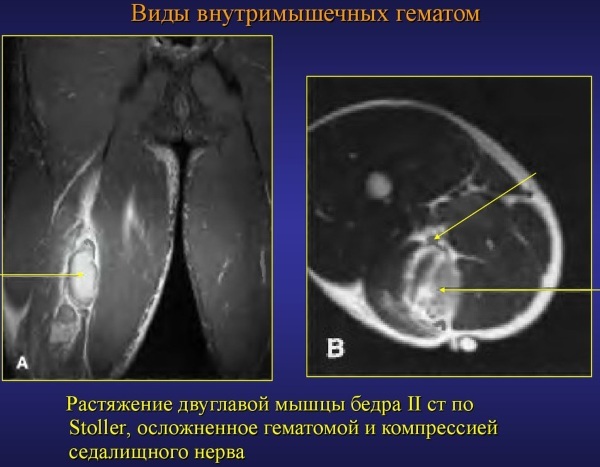
After that, the traumatologist examines the limb. By external signs, he determines whether there is a swelling or hematoma in the thigh area. He also asks the patient to move the toes and try to bend and straighten it.
At this stage, it may be suspected that the patient suffered not only from a sprain, but also from a fracture. To exclude this possibility, it is required to undergo a computer examination of an MRI or CT scan. In some situations, the doctor prescribes an ultrasound scan and X-ray.
Only then will the doctor determine which therapeutic measures are most appropriate in the given situation.
Conservative treatment
In most cases, for severe pain, the doctor prescribes complex analgesics, as well as anti-inflammatory drugs. It is allowed to use ointments with a cooling or, conversely, a warming effect (which exactly the doctor decides). Additional medications are prescribed depending on the symptoms and other features of the injury.
More often the traumatologist prescribes:
- Ibuprofen or Aspirin. These drugs are anti-inflammatory and pain relievers. Also, these medicines relieve puffiness.
- Heparin ointment, Nikovenna. These formulations have a cooling effect. Thanks to such ointments, pain and swelling can be reduced. These products include analgesics and essential oils. The use of such medications does not increase the patient's body temperature.
- Nikoflex or Dolpik. These are warming ointments that are usually used during the rehabilitation period. That is, it is better not to use such drugs immediately after injury, as they can aggravate the inflammatory process. Warming ointments contain bee or snake venom. Means of this type dilate blood vessels.
-
Pain relieving ointments. The most effective remedy is Traumeel S, Fastumgel. These topical medications include ibuprofen and other anti-inflammatory and analgesic components. This type of medication can be used immediately after injury and during rehabilitation.
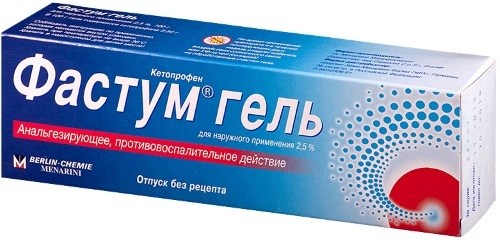
In more difficult situations, the patient is prescribed immobilization. For this, the victim's leg is fixed with the help of special devices. If the strain is severe and the muscles are severely damaged, surgery may be required.
Typically, surgery is performed when structures are ruptured. Also, similar measures are performed if deformations were detected during the diagnosis.
Restorative activities
A sprain on the back of the thigh, which is usually treated with pills and ointments, requires more than proper therapeutic interventions immediately after injury. It is equally important to adhere to the doctor's recommendations during the recovery period, which can last several months.
Physiotherapy
This is a fairly wide range of a wide variety of procedures. The highest efficiency is demonstrated by electrophoresis and magnetotherapy. Also, during the recovery process, the doctor may suggest a course of treatment with ultrasound.
Good results have been observed when using compresses. The exact list of activities depends on the specific situation. The doctor will consider the severity of the injury and make an optimal schedule of procedures.
Exercise therapy
As a rule, this type of activity is required after surgery or medical treatment in case of rather serious damage. As a rule, the doctor first prescribes the so-called passive exercises. Restorative measures begin during the immobilization period. At this time, it is important to keep the limbs in good shape.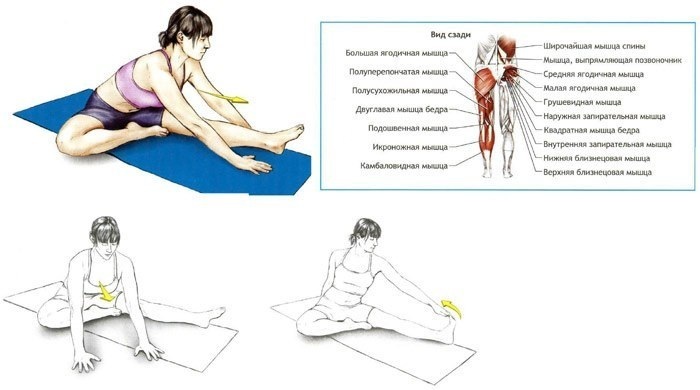
Gradually, the patient begins to walk on crutches. After that, the doctor allows you to perform exercises for half-squatting, pulling the legs to the sides. All exercises are performed in a gentle mode, in several rounds. After removing the immobilization and devices for fixing the limb, the list of exercises expands.
The patient begins more intense training using special equipment. Then you can move on to running and other activities. If in the process of training the patient begins to experience pain, then the exercises should be completed immediately.
Massage
Stretching the back of the thigh, the treatment of which includes complex measures, in most situations does not affect the patient's quality of life. But this is only possible if complex measures are performed during the recovery process, which also include specialized massage. The course of such a recovery usually begins 2 weeks after injury.
If the patient has a plaster cast or other equipment to immobilize the limb, then a so-called passive massage is performed first. That is, the specialist kneads the areas located near the back of the thigh. When the immobilization ends, a full massage is performed.
Taping and elastic bandage
In modern medicine, experts are skeptical about the use of tapes for limb immobilization. As a rule, taping is included only in the final stages of recovery. It is also recommended to use tapes as a prophylaxis, for example, during training, in order to protect limbs from sprains.
Tapes are elastic tapes with an adhesive backing. This is a more modern analogue of an elastic bandage. The strips are glued to specific areas rather than covering the entire leg or arm.
However, they are not able to immobilize the limb, but only redistribute the load. Therefore, when restoring, taping is used only in case of minor damage.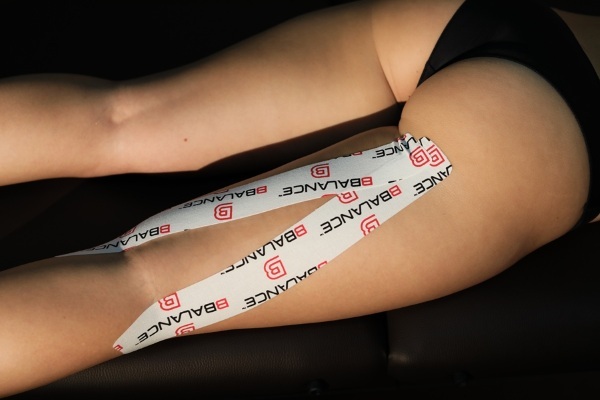
If the back of the thigh is stretched, the tape should be applied from the bottom up. At the same time, the ends of the tapes do not need to be tightly pulled, but in the center of the tape you need to create 50% tension. The number of tapes is determined depending on the specific damage. Bandage is a cheaper fixation device.
When using such a tool, you need to adhere to several rules:
- Relax your muscles as much as possible.
- Take the most natural body position.
- Do not bandage too tightly. If pain occurs during fixation of the limb, you need to loosen the bandage.
It is important that the bandage does not interfere with lymphatic drainage and cause blockage of the joints. It is also worth paying attention to the material of the bandages. Cotton products absorb ointments, while acrylic counterparts have a warming effect.
Terms of rehabilitation
There is no clear time frame for full recovery. It all depends on the rate of healing of the injury, the age of the person, his physical condition and many other factors. It is equally important how severe the patient's trauma is, whether he suffers from complications due to untimely access to a traumatologist.
After conservative treatment and a rehabilitation period, the doctor can observe the patient for another 2-3 weeks.
However, there are approximate terms within which recovery most often occurs:
- With a mild degree of damage, a person fully recovers in 1.5-2 weeks (possibly faster).
- For more serious muscle injuries (if a grade 2 strain is diagnosed), the full course of treatment and recovery may take 4 to 9 weeks. In case of complications, the term increases.
- In severe injuries, ligament rupture and bone fractures are common. In this case, recovery can take from 8 to 20 weeks in the absence of complications.
Folk methods
If the doctor is not against the use of traditional medicine, then you can alleviate the condition after stretching as follows:
- Beer broth. To prepare it, you need to warm up the beer in a water bath, without bringing it to a boil. After that, you need to moisten a cotton towel or cheesecloth in the liquid, squeeze it and sprinkle with ground pepper. Next, you need to apply a beer compress to the affected area for 15 minutes.
-
Barberry. The branches, roots, and bark of the plant are used to relieve symptoms. Pour the dry mixture with 1 tbsp. water and cook over low heat for about 10 minutes. After that, it is required to cool the liquid, moisten the tissue in it and apply it to the thigh for 10-15 minutes.

- Onion. For such therapy, it is necessary to finely chop the onion and mix it with sugar to make a gruel. The resulting mass must be wrapped in gauze and placed on the damaged area of the body for 1 hour. It is recommended to do this compress twice a day.
- Blue clay. Pharmacy clay in powder form must be diluted with water to get a fairly thick mixture. The resulting composition must be removed to the refrigerator until it hardens completely. After that, the resulting cake must be applied to the affected area of the body every 5-6 hours.
- Milk. To alleviate the condition, you need to moisten a towel in milk and apply it to the back of the thigh. When the towel is dry, you need to replace it with another cloth soaked in milk.
Possible complications of spraining
If you do not seek help in a timely manner, then there is a risk of developing degenerative changes in the joints. This means that a person may develop arthrosis. Also, a similar diagnosis is often made if the patient has suffered from cartilage injury.
Among the complications, it is worth noting a muscle hernia. It can form if the connective membrane covering the muscle is damaged. As a rule, professional athletes are more likely to suffer from such complications.
Forecast
In general, at 1-2 degrees of damage, the forecasts are positive. The patient may need a rather long recovery, but after that he will not experience difficulties in movement. If we are talking about a severe degree of damage, then it is possible that after recovery the person will limp. Complete loss of limb mobility occurs only with serious complications.
When stretching the hind limb of the thigh, a person does not always realize the complexity of the injury. Because of this, the treatment is not carried out properly. To prevent this from happening, it is important to monitor the loads and use braces to prevent sprains.
Thigh Stretch Videos
Restoring complex for the back of the thigh:



